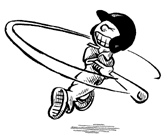
|
Physics and Acoustics of Baseball & Softball Bats
Daniel A. Russell, Ph.D. Graduate Program in Acoustics The Pennsylvania State University The contents of this page are ©2003-2011 Daniel A. Russell | 
|

|
Physics and Acoustics of Baseball & Softball Bats
Daniel A. Russell, Ph.D. Graduate Program in Acoustics The Pennsylvania State University The contents of this page are ©2003-2011 Daniel A. Russell | 
|
However, the parameters of a softball (weight, COR, and compression) can vary significantly from ball to ball, and the performance of a bat depends rather strongly on these ball parameters. If the balls typically used in the field have a different weight, COR or compression than the ball used in the laboratory test, then the simple procedure above will not accurately predict BBS in the field. The fix to this problem is to attempt to normalize the laboratory test results to the parameters of a "standard" ball.
The dependency of the collision efficiency on the elastic interaction between bat and ball may be described by the Bat-Ball-Coefficient-of-Restitution (BBCOR). The BBCOR is often represented by the symbol e and represents the ratio of the combined speeds of the ball (vball-exit) and bat (vbat-recoil) after the collision divided by the initial speed of the ball (vball) before the collision.
The way the ASA BBS standard works is as follows. The moment-of-ineritia of the bat and the mass of the test ball are measured, so that the kinematic factor may be calculated from equation (3). The collision efficiency is measured using the ball-in/ball-out method in equation (2). Then, equation (4) is rearranged in order to calculate the BBCOR in terms of the measured collision efficiency (as a ratio of ball speeds) and kinematic factor:
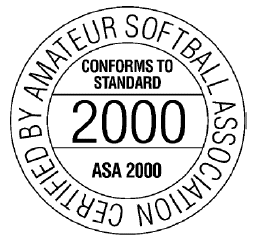 |
The Amateur Softball Association began regulating the performance of slow-pitch softball bats in 2000.[2] At that time the industry standard for testing the performance of softball bats was to follow the test protocol outlined in ASTM Test Standard F1890[3]. Note that while this test protocol bears the phrase "bat performane factor" in its title, the ASA has never used the BPF performance standard, but instead has always used a Batted-Ball Speed standard. They just followed the test protocol outlined in ASTM F1890 to determine a value for BBS. The version of the test standard in use at the time ASA begain regulating bats is designated F1890-98. This version of the test standard made the following assumptions:
|
During the 2002 ASA National Tournament in Montgomery, AL, an extensive field study[4,5] of bat swing speed and bat performance was conducted. The data from this field study, along with other concurrent laboratory studies[6,7] revealed that all of the assumptions made in the F1890-98 test standard were incorrect.
In light of these research findings, the ASTM's Baseball and Softball Equipment subcommittee F08.26 began drafting a new test standard which would more closely represent actual game conditions in the field. The new test standard, ASTM F2219[8], still uses a cannon to propel balls towards an initially stationary bat gripped in a freely rotating pivot. But, the following changes and improvements were made:
| One very important discovery from the 2002 field study and subsequent laboratory validation of the new F2219 test standard was the fact that BBS values determined using the old F1890 standard were significantly underestimating bat performance in the field. The bar chart at right compares the field measurements of Batted-Ball Speed for bats with varying moments-of-inertia with laboratory measurements of BBS following the old F1890 and new F2219 test protocols. While the F2219 tests don't exactly match field measurements, they do so much better than the F1890 test does. |
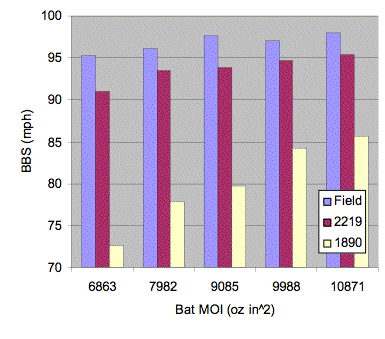
| A second important discovery was that the old F1890 standard was not correctly predicting the difference between high performing bats and the extremely high performing composite bats that began appearing in 2001 and 2002. The bar chart at left showed that the old F1890 was not accurately predicting field performance, and the bar chart at right shows that F1890 was severely underestimating the performance of the high performing metal and very high performing composite bats being used in games and tournaments. |
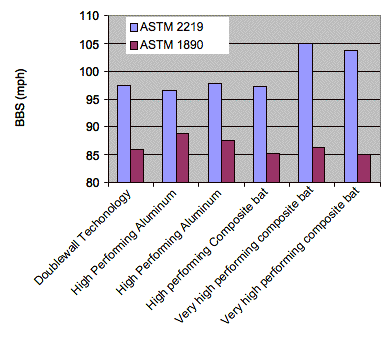
|
|
In 2002 the ASA commissioned a study of a wide variety bats encompassing the 30-year history of non-wood bat types as well as covering the entire range of performance.[2,4] Approximately two dozen bats were tested with the F2219 standard using 0.44/375lb softballs. Bats included in this "era" study included wood, single-walled aluminum, double-walled aluminum, titanium, and composite bats. As shown in the bar-chart at right[4], the study showed BBS values ranging from 90-mph to over 110-mph.
|
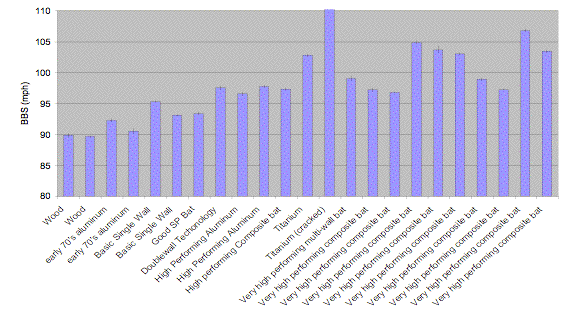
|
|
According to the ASTM F2219 test protocol, a softball (with tight restrictions on weight, COR and compression) is fired from a cannon at 110mph towards a stationary bat. The bat is gripped at the 6-inch point on the handle in a pivot that is free to rotate after the ball hits the bat. The photograph below shows the cannon at the Sports Science Laboratory at Washington State University. The ball is held by a sabot and is placed in to the cannon just in front of the breach plate in the photo. The large gray tank on the left provides the compressed air used to fire balls from the cannon. A couple of movies showing the cannon in action are available form the WSU Sports Science Laboratory website.
|
As the ball exits the cannon, the sabot is caught by the arrestor plate, while the ball continues on and passes through a series of three light gates. Each gate is triggered when the ball breaks the plane of light, and the ball speed is measured as the distance between pairs of light gates divided by the time between trigger signals. Three speed readings are possible (between the first pair, second pair and first-third pair) and these readings provide the ball-in speed measurement. After colliding with the bat, the ball rebounds and passes through the same light gates, only in reverse order. The ball must rebound through at least two of the light gates to be considered a valid hit, and a high-speed camera is used to monitor the trajectory of the rebounding ball. The ratio of ball-out to ball-in speeds determines the collision efficiency or BESR.
|
This photo shows the bat in its pivot. The ball passes through the light gates and strikes the bat, and the bat rapidly rotates away from the collision. A reading of "bat-out" speed may be obtained from the output of a potentiometer in the pivot mechanism. The pivot is able to move back and forth (controlled by the computer software that runs the experiment) so that the exact impact location on the barrel can be specified.
|
|
An additional problem with "bat-out" measurements is that the bat often vibrates violently while it is rotating and recoiling from the collision. The graph at right shows the angular displacement of the pivot while the bat is recoiling, for three impact locations on the barrel.[4] The blue trace (impact at 24" from the knob) shows strong vibration contributions from the first two bending modes. The magenta trace (impact at 28" from the knob) represents an impact at the node of the first bending mode so that only the higher frequency second bending mode contributes to the vibration. The yellow trace (impact at 32" from the knob) represents an impact at the node of the second bending mode so that only the lower frequency first bending mode contributes to the vibration. This trace is especially interesting because it shows the pivot actually coming to rest and rotating in the opposite direction as the flexing of the handle counteracts the rigid body rotational motion of the bat. This data was measured with a potentiometer in the pivot holding the bat. It may possible to minimize the effects of vibration somewhat by measuring the "bat-out" speed at the location of impact on the barrel.[9]
At the moment, however, the question of using a "bat-out" measurement to obtain the collision efficiency for the ASA BBS standard may be somewhat of a moot point. Richard Brandt, the inventor of the Bat Performance Factor, has patented the "bat-out" technique[10] and subsequently sued the ASA to prevent them from using it to certify bats.* The lawsuit has been settled out of court, and all references to BPF and "bat-out" measurements have been removed from the current version of ASTM F2219. * As of May 2008, the ASA has apparently reached an agreement wth Dr. Brandt to allow use of a Bat-Out measurement (through a potentiometer in the pivot) for the testing and certification of softball bats for the ASA. |
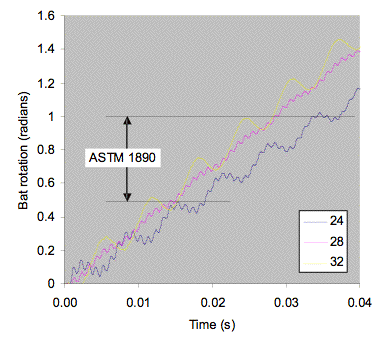
|
|
Correcting for Nonstandard Ball Weight According to the ASTM standard F2219, softballs used to certify bats high speed test must weigh between 6.75 and 7.00 ounces (191.0-198.1 grams). But what if an organization's governing body wanted to use a ball whose weight typically lies outside this narrow range? In order to correctly predict batted-ball speed in the field, the calculated BBS must be normalized to ball weight in order to account for this variation in ball weight. So how does this work? The bat-ball-coefficient-of-restitution (BBCOR) is obtained from the laboratory measurement of the ratio of ball-out to ball-in speeds and the inertia properties of the specific ball and bat |
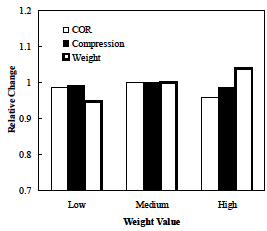
|
|
Correcting for Nonstandard Ball COR The effect of varying the Coefficient-of-Restitution (COR) of a softball on bat performance is much more significant, especially for high performance bats. And, the actual COR of a gross of softballs can vary considerably from the value printed on the ball cover. The ASTM standard protocols require that the balls used to test bats have COR values between 0.420 and 0.440. However, several organizations sponsor tournaments and leagues where balls with COR values of 0.40 or 0.47 are used, and it is necessary to normalize the calculated prediction of BBS to the ball COR if one wants to accurately predict bat performance in the field with balls that are different from those used in the laboratory tests. In the first two published versions of the ASTM standard, F2219-02 (2002) and F2219-04 (2004) the calculated BBS was normalized to the COR of a "standard" ball by adjusting the equation used to calcualte the normalized collision efficiency as The top chart at right shows parameters for three softballs with the same weight (6.72oz) and compression (464lb), but varying COR values (0.41, 0.46, 0.51).[11] The middle chart at right shows the calculated Batted-Ball Speeds for four softball bats of varying levels of performance when tested with these three balls. The BBS results have been normalized for both weight and ball COR. The BBS values for the 87-mph wood bat are the same - the COR normalization works for a very low performing wood bat. However, the COR normalization does not work as well for the other three bats. The failure is especially evident for the 104-mph high performance bat. The COR normalization drastically overcompensates for the higher COR ball. Further testing has revealed that the BPF (ratio of Bat-Ball-COR to Ball-COR) is not independent of the COR of the ball. This throws into question the entire validity of the BPF standard as a legitimate predictor of performance. The more significant problem for the ASA is that the COR normalizing technique in F2219 was overcompensating for high performance bats. In light of this data, the COR normalization was removed from the ASTM F2219 test standard in 2005. (ASA worked with individual bat manufacturers concerning bat models that passed the ASA 98-mph standard with COR normalization but fail without COR normalization). Normalizing to ball COR is not part of the most current version of the F2219 standard. The bottom chart at right shows the calculated BBS for the same bats and the same three balls (varying COR) when the results were normalized to weight only. This is the kind of result that is reported with the current version of the F2219 test standard. Low performance bats produce lower calculated BBS values with high COR balls, and high performance bats produce slightly lower calculated BBS values with high COR balls. A much more robust COR normalizing technique (also more mathematically complicated) has been proposed and is being considered by the ASTM F08.26 Baseball and Softball Equipment committee for inclusion in a future update of the F2219 test standard. Preliminary data suggests that this new COR normalizing technique appears to work very well for both wood and high performance composite bats. Further testing is underway to ensure the stastitical repeatibility of this new technique is before this new normalization technique will be adopted. Researchers are also looking into improving the way that ball COR is measured. Currently, COR is measured as the ratio of ball-out to ball-in speeds when a ball is fired from a cannon with an initial speed of 60-mph towards a rigid wall. 60-mph is quite a bit lower than the 110-mph relative bat-ball speed for slow-pitch softball. Plentiful data exists showing that ball COR decreases as ball speed increases. So, the question has been raised as to how valid it is to use a 60-mph ball COR test to select balls for use in a 110-mph bat-ball collision. Research is currently underway to determine a more approriate speed for COR measurements. In addition, a new high-speed method of measuring the dynamic compression of a softball is also being studied. |
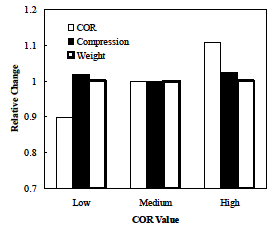
Three softballs with the same weight and compression but different COR.
|
|
Correcting for Nonstandard Ball Compression Static compression is measured as the amount of force in pounds required to squish a softball (or baseball) a distance of 0.25-inches. Typical compression values for softballs are 150-lb ("mush" balls), 375-lb mid-compression balls, and 525-lb high compression balls. Variations in the compression of the ball in use can also have a noticeable effect on the performance of the bat being used to hit the ball. And variations in the actual compression of a box of softballs from the same manufacturer can be significant. The top chart at right shows parameters for three softballs with nearly the same weight (6.95oz) and COR (0.44), but varying static compression values (341lb, 391lb, and 452lb).[11] The bottom plot at right shows the calculated BBS for four softball bats, of varying performance, tested with these three softballs. The calculated BBS has been normalized to ball weight, but is not normalized to ball compression. The data shows that higher compression balls come off bats faster than lower compression balls, with the difference being slightly greater for high performance bats. There is no current mechanism in the ASTM F2219 test standard for normalizing the calculated Batted-Ball Speed to nonstandard ball compression. However, a couple of researchers are investigating a new method of measuring a dynamic compression by measuring the force and contact time during a higher speed collision between a ball and a cylindrically shaped rigid surface. Initial results suggest this new dynamic compression test might be able to distinguish between new multi-layer softballs that have the same COR and the same 0.25-inch static compression as traditional softballs, but which - when used with the same bat - produce batted-balls speeds that are 7-mph faster. Several research labs are attempting to collect and correlate data for this new measurement technique, and once the results are verified a new ASTM standard may be written for dynamic compression. |
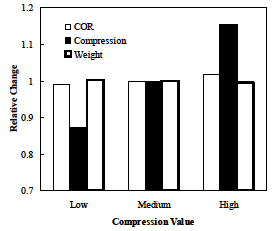
Three softballs with the same weight and COR but different static compresison.
|